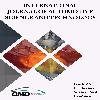Investigation of Polymer Matrix Metarials in Automotive Consoles
Investigation of Polymer Matrix Metarials in Automotive Consoles
Research on reducing the weight of automobiles, achieving fuel consumption andreducing harmful exhaust emissions focuses on the research of new materials. Thepolymer matrix is the most widely used material for re-spectra for composite applications within the scope of the redial field mentioned above. Because polymer materials are inexpensive and improve their physical and mechanical properties, theyare used in many applications to replace metal licensed materials. The front barrierof a car made of glass fiber-reinforced polymer composite material can achieve a35-mph crash test. In addition to providing the same level of collision safety assteel, poly-mer composites can provide improved performance with features such asvibration control. In this study, the use of plastic materials in the automotive sectorand the sections used were examined, the researches were made on the basis of theuse of polypropylene materials in the vehicle front consoles and the tensile strengthof the samples taken from the front consoles were examined. At least two sampleswere used for each material type in the experiments. Tensile strength values of thematerial were obtained with tensile test. The tensile test was carried out at roomtemperature. Materials were examined according to tensile test results and performance evaluation was made based on tensile strength. According to the results ofthe evaluation, C model was found to be the most useful material.
___
- [1] Thakur, V.K., Thakur, M.K., Gupta, R.K. (2014). Review: raw natural fiber-based polymer composites. Int. J. Polym. Anal. Charact, 19, 256-271.
- [2] Ku, H., Wang, H., Pattarachaiyakoop, N., Trada, M. (2011). A review on the tensile properties of natural fiber reinforced polymer composites. Compos. Part B Eng, 42, 856-873.
- [3] Barari, B., Ellingham, T., Qamhia, I., Pillai, K., El-Hajjar, R., Turng, T. et al. (2016). Mechanical characterization of scalable cellulose nano-fiber based composites made using liquid composite molding process. Compos. Part B Eng 277-284.
- [4] Unterweger, C., Brüggemann, O., Fürst, C. (2014). Synthetic fibers and thermoplastic short-fiber-reinforced polymers: properties and characterization. Polym. Compos, 35, 227-236.
- [5] Santos, T., Vasconcelos, G., Souza, W., Costa, M., Botelho, E. (2015). Suitability of carbon fiber-reinforced polymers as power cable cores: Galvanic corrosion and thermal stability evaluation. Mater Design, 65, 780-788.
- [6] Pei, X-Q., Bennewitz, R., Schlarb, A.K. (2015). Mechanisms of friction and wear reduction by carbon fiber reinforcement of Peek. Tribol Lett, 58, 1-10.
- [7] Bahadur, S., Zheng Y. (1990). Mechanical and tribological behavior of polyester reinforced with short glass fibers. Wear, 137, 251-266.
- [8] Zhang, S. (1998) State-of-the-art of polymer tribology Tribol. Int 31, 49-60.
- [9] Zhang, Y., Zhu, S., Liu, Y., Yang, B., Wang, X. (2015). The mechanical and tribological properties of nitric acid-treated carbon fiber-reinforced polyoxymethylene composites J. Appl. Polym. Sci, 132.
- [10]Cintil Jose Chirayil, Jithin Joy, Hanna J. Maria, Igor Krupa, Sabu Thoma, (2015). Polyolefins in Automotive Industry. Polyolefin Compounds and Materials pp 265-283
- [11]Claire S. Boland, Robb De Kleine, Gregory A. Keoleian, Ellen C. Lee, Hyung Chul Kim, and Timothy J. Wallington, (2016). Life Cycle Impacts of Natural Fiber Composites for Automotive Applications: Effects of Renewable Energy Content and Lightweighting. Journal of Industrial Ecology Volume20, Issue1 Pages 179-189
- [12]Herrera-Franco, P.J. and Valadez-Gonza´lez, A. (2004). Mechanical properties of continuous natural fibre-reinforced polymer composites. Composites Part A 35, 339–345.
- [13]Selzer R. and Friedrich K. (1997). Mechanical properties and failure behaviour of carbon fibre-reinforced polymer composites under the influence of moisture, Composites Part A 28A, 595- 604.
- [14]Faris M. AL-Oqla, Sapuan, S.M. (2014). Natural fiber reinforced polymer composites in industrial applications: feasibility of date palm fibers for sustainable automotive industry. Journal of Cleaner Production 66, 347-354.
- [15]Phetphaisita, C. W., Namahoota, J., Saengkiettiyutb, K., Ruamcharoenc, J. (2015). Polphat Ruamcharoen Green metal organic coating from recycled PETs and modified naturalrubber for the automobile industry. Progress in Organic Coatings 86, 181–189.
- [16]Ku, H., Wang, H., Pattarachaiyakoop, N., Trada, M. (2011). A review on the tensile properties of natural fiber reinforced polymer composites, Composites: Part B 42, 856–873.
- [17]Miao, C. and Hamad, W.Y. (2013). Cellulose reinforced polymer composites and nanocomposites: a critical review, Cellulose, 20:2221–2262.
- [18]Saffet, G (2018-Ocak). Otomotiv Endüstrisinde Kullanılan Polimer Matrisli Kompozit Malzemeler, Yüksek Lisans Tezi, Pamukkale Üniversitesi, Fen Bilimleri Enstitüsü.
- [19]Muhammad Hanafi Md S. (2017). Mechanical Properties of Coconut Shell Powder Reinforced PVC Composites in Automotive Applications, Journal of Mechanical Engineering, Vol 14(2), 49-61.
- [20]Savaşçı, Ö.T., Uyanık, N., Akovalı, G. (1999). Plastikler ve Plastik Teknolojisi, PAGEV Yayınları, İstanbul.
- Yayın Aralığı: Yılda 4 Sayı
- Başlangıç: 2016
- Yayıncı: Otomotiv Mühendisleri Derneği
Sayıdaki Diğer Makaleler
Investigation of Polymer Matrix Metarials in Automotive Consoles
Mehmet Çakmakkaya, Mehmet Kunt, Oğuzhan Terzi
Investigation of Polymer Matrix Composites in Automotive Consoles
Mehmet ÇAKMAKKAYA, Mehmet KUNT, Oğuzhan TERZİ
Mustafa Babagiray, Hüseyin Bayrakçeken, Mehmet Çakmakkaya, Faruk Emre Aysal, Salih Karanfil
